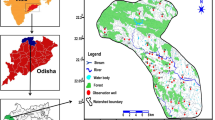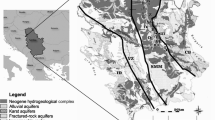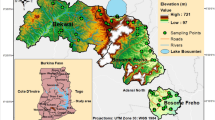This study investigated the hydrogeochemical processes of groundwater in the Tasuj plain, Iran. The Tasuj plain is one of the 12 marginal plains around Urmia Lake which is currently under a critical ecological condition. In the last decades, the Tasuj plain aquifer suffered from severe groundwater level declination and caused degradation of groundwater quality. To better understand hydrogeochemical processes in the Tasuj plain, this study adopted graphical methods and multivariate statistical techniques to analyze groundwater samples. A total of 504 groundwater samples was obtained from 34 different locations (qanats, wells, and springs) over 12 years (1997–2009) and analyzed for 15 water quality parameters. From the results, the Piper diagram indicated four groundwater types and the Stiff diagram showed eight different sources of groundwater samples. The Durov diagram identified five major hydrogeochemical processes in the aquifer. However, hierarchical cluster analysis (HCA) identified five water types in the groundwater samples because HCA was able to analyze more chemical and physical data than graphical methods. The HCA result was checked by discriminant analysis and found consistency in all samples that were classified into correct groups. Using factor analysis, we identified three factors that accounted for 81.6% of the total variance of the dataset. Based on the high factor loadings of the variables, factors 1 and 2 reflected the natural hydrogeochemical processes and factor 3 explained the effect of agricultural fertilizers and human activities in the Tasuj plain. Dendrograms from 2000 to 2009 were studied to understand the temporal variation of groundwater quality. Comparing the distributions of groundwater types in 2000 and 2009, we found that the mixing zone was expanded. This may be due to artificial groundwater recharge in the recharge area and the effect of inverse ion exchange in the discharge area.












Similar content being viewed by others
References
Abkav Consulting Engineering Co. 1973 Geophysical studies reports of Tabriz, Tasuj and Shabestar plains; East Azerbaijan Regional Water Authority (in Persian).
Adams S, Titus R, Pietersen K, Tredoux G and Harris C 2001 Hydrochemical characteristics of aquifers near Sutherland in the Western Karoo, South Africa; J. Hydrol. 241(1–2) 91–103.
Al-Shaibani A M 2008 Hydrogeology and hydrochemistry of a shallow alluvial aquifer, western Saudi Arabia; Hydrogeol. J. 16(1) 155–165.
American Public Health Association 1998 Standard Method for the Examination of Water and Wastewater; 17th edn (Washington, DC).
Asghari Moghaddam A and Fijani E 2008 Distribution of fluoride in groundwater of Maku area, northwest of Iran; J. Environ. Geol. 56(2) 281–287.
Asghari Moghaddam A and Fijani E 2009 Hydrogeologic framework of the Maku area basalts, northwestern Iran; Hydrogeol. J. 17(4) 949–959.
Berberian M and King G C P 1981 Towards the paleogeography and tectonic evolution of Iran; Canadian J. Earth Sci. 18(2) 210–265.
Chae G T, Kim K, Yun S-T, Kim Y-H, Kim S-O, Choi B-Y, Kim H-S and Rhee C W 2004 Hydrogeochemistry of alluvial groundwaters in an agricultural area: An implication for groundwater contamination susceptibility; Chemosphere 55(3) 369–378.
Chen K, Jiao J J, Huang J and Huang R 2007 Multivariate statistical evaluation of trace elements in groundwater in a coastal area in Shenzhen, China; Environ. Pollut. 147(3) 771–780.
Cloutier V, Lefebvre R, Therrien R and Savard M M 2008 Multivariate statistical analysis of geochemical data as indicative of the hydrogeochemical evolution of groundwater in a sedimentary rock aquifer system; J. Hydrol. 353(3–4) 294–313.
Dalton M G and Upchurch S G 1978 Interpretation of hydrochemical facies by factor analysis; Ground Water 16(4) 228–233.
Davis J C 1986 Statistics and Data Analysis in Geology; New York, Wiley, 647p.
Davis S N and Dewiest R J M 1966 Hydrogeology; Krieger Publication Co., 476p.
de Martonne E 1925 Traité de Géographie Physique: 3 tomes, Paris.
Dragon K 2006 Application of factor analysis to study contamination of a semi-confined aquifer (Wielkopolska Buried Valley aquifer, Poland); J. Hydrol. 331(1–2) 272–279.
Durov S A 1948 Natural waters and graphic representation of their composition: Dokl; Akad. Nauk. SSSR 59 87–90.
East Azerbaijan Regional Water Authority 2001 Studying of groundwater resources and mathematical modeling of Tasuj Plain using GIS; Vol. I, p. 212 (in Persian).
East Azerbaijan Regional Water Authority 2010 Annual report of water balance of Tasuj plain (in Persian).
Emberger L 1930 Sur une formule applicable en géographie botanique; Cah. Herb. Seanc. Acad. Sci. 191 389–390.
Grande A, Gonzalez R, Beltran R and Sanchez-Rodas D 1996 Application of factor analysis to the study of contamination in the aquifer system of Ayamonte-Huelva (Spain); Ground Water 34(1) 155–161.
Guler C, Thyne G D, McCray J E and Turner A K 2002 Evaluation of graphical and multivariate statistical methods for classification of water chemistry data; Hydrogeol. J. 10(4) 455–474.
Helena B, Pardo B, Vega M, Barrado E, Fernandez J M and Fernandez L 2000 Temporal evolution of groundwater composition in an alluvial aquifer (Pisuerga River, Spain) by principal component analysis; Water Research 34(3) 807–816.
Hem J D 1986 Study and interpretation of the chemical characteristics of natural water; U.S. Geol. Survey Water-Supply Paper, 363p.
Hossain G, Howladar M F, Nessa L, Ahmed S S and Quamruzzaman C 2010 Hydrochemistry and classification of groundwater resources of Ishwardi Municipal Area, Pabna District, Bangladesh; Geotech. Geol. Eng. 28(5) 671–679.
Hounslow A W 1995 Water Quality Data: Analysis and interpretation; Lewis Publisher, 397p.
Jackson J E 1991 A User’s Guide to Principal Components; Wiley, New York.
Jiang Y, Wue Y, Groves C, Yuan D and Kambesis P 2009 Natural and anthropogenic factors affecting the groundwater quality in the Nandong karst underground river system in Yunan, China; J. Cont. Hydrol. 109(1–4) 49–61.
Johnson R A and Wichern D W 1992 Applied Multivariate Statistical Analysis; Prentice-Hall International, Englewood Cliffs, NJ, USA, 642p.
Kaiser H F 1958 The Varimax criterion for analytic rotation in factor analysis; Psychometrika 23(3) 187–200.
Khazaei E, Stednick J D, Sanford W E and Warner J W 2006 Hydrochemical changes over time in the Zahedan aquifer, Iran; Environ. Monit. Assess. 114(1–3) 123–143.
Khodabandeh A A and Amini-Fazl A 1993 Geological map of Tasuj sheet (1:100,000); Geological Survey of Iran.
Laaksoharju M, Tullborg E-L, Wikberg P, Wallin B and Smellie J 1999 Hydrogeochemical conditions and evolution at the Äspö HRL, Sweden; Appl. Geochem. 14(7) 835–859.
Lambrakis N, Antonakos A and Panagopoulos G 2004 The use of multicomponent statistical analysis in hydrogeological environmental research; Water Res. 38(7) 1862–1872.
Lloyd I W 1965 The hydrochemistry of the aquifers of North-Eastern Jordan; J. Hydrol. 3(3–4) 319–330.
Lloyd J W and Heathcote J A 1985 Natural inorganic hydrochemistry in relation to groundwater – An introduction; Clarrendon Press, Oxford, 296p.
Matalas C N and Reiher J B 1967 Some comments on the use of factor analysis; Water Resour. Res. 3(1) 213–223.
Piper A M 1944 A graphical procedure in the geochemical interpretation of water analyses; Am. Geophys. 25 914–923.
Reghunath R, Murthy T R S and Raghavan B R 2002 The utility of multivariate statistical techniques in hydrogeochemical studies: An example from Karnataka, India; Water Res. 36(10) 2437–2442.
Research Center of Agriculture and Natural Resources of East Azerbaijan Province 2010.
Schwartz F W and Zhang H 2003 Fundamentals of Groundwater; John Wiley and Sons, 583p.
Singh P K, Malika A, Mohana D and Sinhab S 2004 Multivariate statistical techniques for the evaluation of spatial and temporal variations in water quality of Gomti River (India) – a case study; Water Res. 38(18) 3980–3992.
Singhal B B S and Gupta R P 1999 Applied Hydrogeology of Fractured Rocks; Kluwer Academic Publishers, Dordrecht, The Netherlands, 400p.
SPSS Inc. 2008 SPSS for windows, Version 17.
StatSoft Inc. 2004 Statistica (Data Analysis Software System), Version 6.
Stiff H A 1951 The interpretation of chemical water analysis by means of patterns; J. Petrol. Technol. 3(10) 60–62.
Stocklin J 1968 Structural history and tectonics of Iran: A review; Am. Assoc. Petrol. Geol. 52(7) 1229–1258.
Stocklin J 1974 Possible ancient continental margins in Iran; In: The Geology of Continental Margins (eds) Burk C A and Drake C L (Berlin: Springer), pp. 873–887.
Todd D K and Mays L W 2005 Groundwater Hydrology; John Wiley & Sons, Inc., 636p.
USEPA 2001 U.S. National Primary and Secondary Drinking Water Regularizations (NPDWRs); U.S. Environmental Protection Agencies.
Voudouris K S, Lambrakis N J, Papatheothorou G and Daskalaki P 1997 An application of factor analysis for the study of the hydrogeologicai conditions in Plio-Pieistocene, aquifers of NW Achaia (NW Peloponnesus, Greece); Math. Geol. 29(1) 43–59.
Voudouris K, Panagopoulos A and Koumantakis J 2000 Multivariate statistical analysis in the assessment of hydrochemistry of the Northern Korinthia Prefecture Alluvial Aquifer System (Peloponnese, Greece); Natural Resourc. Res. 9(2) 135–145.
Zaporozec A 1972 Graphical interpretation of water-quality data; Ground Water 10 32–43.
Acknowledgements
This study was supported in part by the Research Office at University of Tabriz. The Iran Ministry of Science, Research and Technology provided scholarship to A A Nadiri and E Fijani to conduct research at Louisiana State University. The authors wish to acknowledge the East Azerbaijan Regional Water Authority for supplying data. Authors wish to thank M Oroji for his kind help during the laboratory works.
Author information
Authors and Affiliations
Corresponding author
Rights and permissions
About this article
Cite this article
NADIRI, A.A., MOGHADDAM, A.A., TSAI, F.TC. et al. Hydrogeochemical analysis for Tasuj plain aquifer, Iran. J Earth Syst Sci 122, 1091–1105 (2013). https://doi.org/10.1007/s12040-013-0329-4
Received:
Revised:
Accepted:
Published:
Issue Date:
DOI: https://doi.org/10.1007/s12040-013-0329-4




